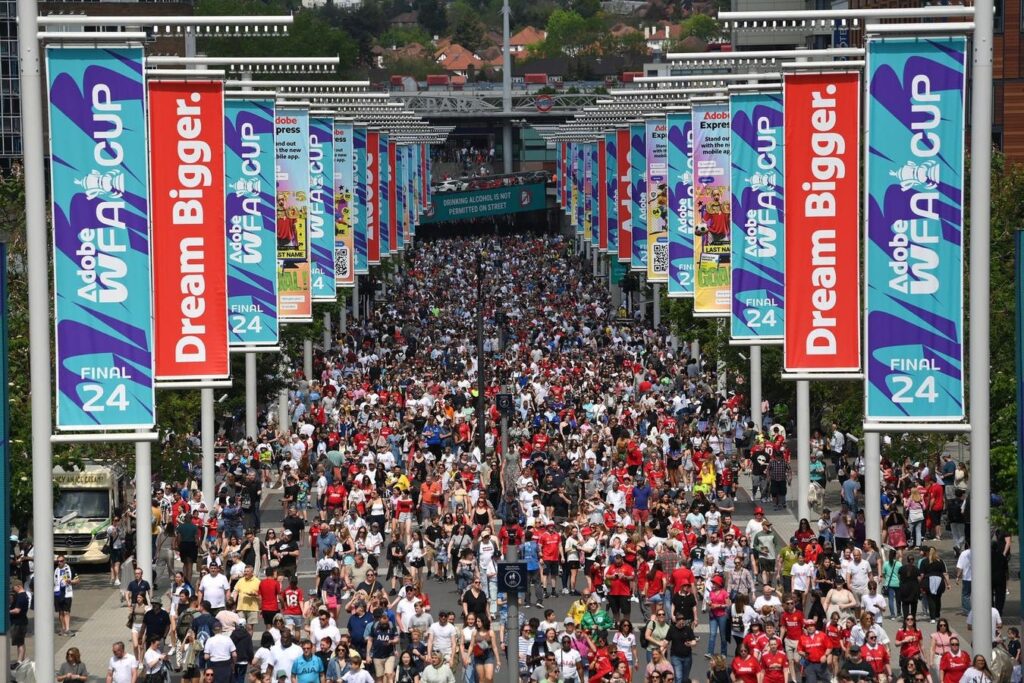LONDON, ENGLAND – MAY 12: Fans walk down Wembley Way as they arrive at the stadium prior to the … More
Getty ImagesA new report by Nielsen Sports and PepsiCo suggests that women’s soccer is on course to reach 800 million fans by 2030 and become the fifth biggest sport in the world.
Undervalued to Unstoppable – leverages data from Nielsen Sports, the global leader in fan intelligence and sponsorship analytics, and PepsiCo, one of the leading investors in women’s sport. They predict a 38% increase in the reach of women’s soccer in the next five years and highlight the opportunity for sponsors to capitalise on a unique opportunity to tap into an affluent new market based on the demographics of that audience.
Over the course of six years, the study noted down respondents who replied ‘interested’ or ‘very interested’ in women’s soccer. Currently the sport has, according to Nielsen Sports, the tenth largest global fanbase behind men’s soccer, basketball, swimming, Formula One, Track and Field, tennis, volleyball, cycling and badmint. The study concludes that, based on the currently trajectory of growth, women’s soccer will enter the top five by the end of the decade.
The projected growth is expected to spike in every other year, coinciding with major women’s international tournaments. In 2029, the year of the next UEFA Women’s Euro, they predict the global fanbase for the game will exceed 800 million before levelling off in 2030.
While in terms of numbers, women’s soccer has the potential to rival Formula One and tennis, it currently lags behind those sports in terms of global sponsorship deals. There is greater fluctuation in activity betweem major tournaments and this season there has a decline in attendances in the Women’s Super League and UEFA Women’s Champions League. The report states that “turning growth into permanence will require investment across the entire ecosystem.”
Europe is seen as the powerhouse in driving the growth of the women’s game. Within the United Kingdom, fan interest in the women’s game doubled between January and July 2022 ahead of the UEFA Women’s Euro hosted by England. With Switzerland staging the competition this year, there has been a 22% increase there in appreciation of the game.
LONDON, ENGLAND – JULY 31: England celebrate during the trophy presentation during the UEFA Women’s … More
Getty ImagesIn terms of participation, player numbers in France have surged by 150% in the past five years and 95% in Spain. In China there has been a staggering 300% rise in girls participating in the sport with an estimated 186 million new fans of the game over the last five years. The research shows those who play the sport are 26% more likely to be dedicated fans.
However, none of the five countries believed to have the largest proportion of women’s soccer fans amongst their demographics are European. With 50% of their population following the women’s game, Colombia, quarter-finalists at the last Women’s World Cup, lead the way ahead of the United Arab Emirates, Mexico, Brazil and India.
Half of all women’s soccer fans are also aged between 25-44. This is above the 44% average for other sports and data indicates that 47% of that group belong to the top income bracket (against 37% of the general population). All of this suggests that sponsors have the potential to capture the most commercially valuable audience in sport.
Back in 2019, 57% of women’s soccer fans were male. However, the research indicates that the split equalised in 2024 and by the end of the decade will skew in the opposite direction with 60% of the sport’s fans expected to be female.
PepsiCo became the first sponsor of the men’s Champions League to support the women’s game in 2019. From next season, Pepsi will, for the first time, replicate it’s glitzy ‘kick-off show’ for the showpiece men’s game at a UEFA Women’s Champions League final in Oslo. This will be expanded into the UEFA Women’s Euro in 2029.
KIEV, UKRAINE – MAY 26: Dua Lipa performs prior to the UEFA Champions League final between Real … More
Getty ImagesThey hope to utilise the cross-over interests of women’s soccer fans. The data indictes that two-thirds of them are also dedicated fans of music and video games, compared to less than half of general sports fans. This opens the door for brands in these adjacent markets to reach the women’s soccer market.
“At PepsiCo, we see women’s football as more than just a sport,” said Jane Wakely, EVP & Chief Consumer Marketing Officer & Chief Growth Officer, International Foods at PepsiCo. “It’s a cultural force with the power to connect, inspire and grow our brands. As a business, we’re proud to partner with UEFA Women’s Football, the FIFA Women’s World Cup, the WNBA and leading athletes across the world, because we know these platforms unlock powerful passion points for an increasingly engaged and influential audience.”
Samantha Lamberti, Head of International at Nielsen Sports, concluded that “we have long believed in the potential of women’s football, and today, we’re no longer just tracking progress, we’re witnessing a breakthrough. From media rights to sponsorship and fan engagement, this is no longer a case of future promise but present value.”
Read the full article here


